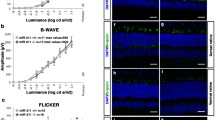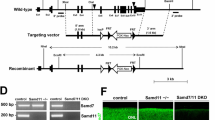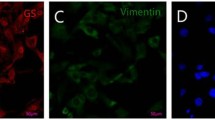Abstract
Retinal histogenesis requires coordinated and temporal functioning of factors by which different cell types are generated from multipotent progenitors. Development of rod photoreceptors is regulated by multiple transcription factors, and Nrl is one of the major factors involved in their fate specification. Presence or absence of Nrl at the postnatal stages decides the generation of cone photoreceptors or other later retinal cells. This suggests the need for regulated expression of Nrl in order to accelerate the generation of other cell types during retinal development. We found that miR cluster 143/145, comprising miR-143 and miR-145, targets and imparts a posttranscriptional inhibition of Nrl. Expression of both miRNAs was differentially regulated during retinal development and showed least expression at PN1 stage in which most of the rod photoreceptors are generated. Downregulation of rod photoreceptor regulators and markers upon miR cluster 143/145 overexpression demonstrated that this cluster indeed negatively regulates rod photoreceptors. Further, we prove that Nrl positively regulates miR cluster 143/145, thus establishing a feedback loop regulatory mechanism. This may be one possible mechanism by which Nrl is posttranscriptionally regulated to facilitate the generation of other cell types in retina.







Similar content being viewed by others
References
Cepko CL (1999) The roles of intrinsic and extrinsic cues and bHLH genes in the determination of retinal cell fates. Curr Opin Neurobiol 9(1):37–46
Young RW (1985) Cell differentiation in the retina of the mouse. Anat Rec 212(2):199–205. doi:10.1002/ar.1092120215
Ahmad I, Das AV, James J, Bhattacharya S, Zhao X (2004) Neural stem cells in the mammalian eye: types and regulation. Semin Cell Dev Biol 15(1):53–62. doi:10.1016/j.semcdb.2003.09.003
Anchan RM, Reh TA, Angello J, Balliet A, Walker M (1991) EGF and TGF-alpha stimulate retinal neuroepithelial cell proliferation in vitro. Neuron 6(6):923–936
Fu X, Kiyama T, Li R, Russell M, Klein WH, Mu X (2009) Epitope-tagging Math5 and Pou4f2: new tools to study retinal ganglion cell development in the mouse. Developmental dynamics: an official publication of the American Association of Anatomists 238(9):2309–2317. doi:10.1002/dvdy.21974
Liu W, Mo Z, Xiang M (2001) The Ath5 proneural genes function upstream of Brn3 POU domain transcription factor genes to promote retinal ganglion cell development. Proc Natl Acad Sci U S A 98(4):1649–1654. doi:10.1073/pnas.98.4.1649
Dyer MA, Livesey FJ, Cepko CL, Oliver G (2003) Prox1 function controls progenitor cell proliferation and horizontal cell genesis in the mammalian retina. Nat Genet 34(1):53–58. doi:10.1038/ng1144
Chen CM, Cepko CL (2000) Expression of Chx10 and Chx10-1 in the developing chicken retina. Mech Dev 90(2):293–297
Ahmad I, Acharya HR, Rogers JA, Shibata A, Smithgall TE, Dooley CM (1998) The role of NeuroD as a differentiation factor in the mammalian retina. Journal of molecular neuroscience: MN 11(2):165–178. doi:10.1385/JMN:11:2:165
Yan RT, Wang SZ (1998) neuroD induces photoreceptor cell overproduction in vivo and de novo generation in vitro. J Neurobiol 36(4):485–496
Furukawa T, Morrow EM, Cepko CL (1997) Crx, a novel otx-like homeobox gene, shows photoreceptor-specific expression and regulates photoreceptor differentiation. Cell 91(4):531–541
Furukawa T, Morrow EM, Li T, Davis FC, Cepko CL (1999) Retinopathy and attenuated circadian entrainment in Crx-deficient mice. Nat Genet 23(4):466–470. doi:10.1038/70591
Swain PK, Hicks D, Mears AJ, Apel IJ, Smith JE, John SK, Hendrickson A, Milam AH et al (2001) Multiple phosphorylated isoforms of NRL are expressed in rod photoreceptors. J Biol Chem 276(39):36824–36830. doi:10.1074/jbc.M105855200
Mears AJ, Kondo M, Swain PK, Takada Y, Bush RA, Saunders TL, Sieving PA, Swaroop A (2001) Nrl is required for rod photoreceptor development. Nat Genet 29(4):447–452. doi:10.1038/ng774
Ahmad I, Dooley CM, Afiat S (1998) Involvement of Mash1 in EGF-mediated regulation of differentiation in the vertebrate retina. Dev Biol 194(1):86–98. doi:10.1006/dbio.1997.8809
Lillien L, Cepko C (1992) Control of proliferation in the retina: temporal changes in responsiveness to FGF and TGF alpha. Development 115(1):253–266
Hicks D, Courtois Y (1992) Fibroblast growth factor stimulates photoreceptor differentiation in vitro. J Neurosci Off J Soc Neurosci 12(6):2022–2033
Ezzeddine ZD, Yang X, DeChiara T, Yancopoulos G, Cepko CL (1997) Postmitotic cells fated to become rod photoreceptors can be respecified by CNTF treatment of the retina. Development 124(5):1055–1067
Kelley MW, Turner JK, Reh TA (1994) Retinoic acid promotes differentiation of photoreceptors in vitro. Development 120(8):2091–2102
Levine EM, Roelink H, Turner J, Reh TA (1997) Sonic hedgehog promotes rod photoreceptor differentiation in mammalian retinal cells in vitro. J Neurosci Off J Soc Neurosci 17(16):6277–6288
Alvarez-Garcia I, Miska EA (2005) MicroRNA functions in animal development and human disease. Development 132(21):4653–4662. doi:10.1242/dev.02073
Bartel DP (2004) MicroRNAs: genomics, biogenesis, mechanism, and function. Cell 116(2):281–297
Jovanovic M, Hengartner MO (2006) miRNAs and apoptosis: RNAs to die for. Oncogene 25(46):6176–6187. doi:10.1038/sj.onc.1209912
Wienholds E, Plasterk RH (2005) MicroRNA function in animal development. FEBS Lett 579(26):5911–5922. doi:10.1016/j.febslet.2005.07.070
He L, Hannon GJ (2004) MicroRNAs: small RNAs with a big role in gene regulation. Nat Rev Genet 5(7):522–531. doi:10.1038/nrg1379
Xu S, Witmer PD, Lumayag S, Kovacs B, Valle D (2007) MicroRNA (miRNA) transcriptome of mouse retina and identification of a sensory organ-specific miRNA cluster. J Biol Chem 282(34):25053–25066. doi:10.1074/jbc.M700501200
Karali M, Manfredi A, Puppo A, Marrocco E, Gargiulo A, Allocca M, Corte MD, Rossi S et al (2011) MicroRNA-restricted transgene expression in the retina. PLoS One 6(7):e22166. doi:10.1371/journal.pone.0022166
Loscher CJ, Hokamp K, Kenna PF, Ivens AC, Humphries P, Palfi A, Farrar GJ (2007) Altered retinal microRNA expression profile in a mouse model of retinitis pigmentosa. Genome Biol 8(11):R248. doi:10.1186/gb-2007-8-11-r248
Ryan DG, Oliveira-Fernandes M, Lavker RM (2006) MicroRNAs of the mammalian eye display distinct and overlapping tissue specificity. Mol Vis 12:1175–1184
Lumayag S, Haldin CE, Corbett NJ, Wahlin KJ, Cowan C, Turturro S, Larsen PE, Kovacs B et al (2013) Inactivation of the microRNA-183/96/182 cluster results in syndromic retinal degeneration. Proc Natl Acad Sci U S A 110(6):E507–E516. doi:10.1073/pnas.1212655110
Li Y, Li C, Chen Z, He J, Tao Z, Yin ZQ (2012) A microRNA, mir133b, suppresses melanopsin expression mediated by failure dopaminergic amacrine cells in RCS rats. Cell Signal 24(3):685–698. doi:10.1016/j.cellsig.2011.10.017
Silva VA, Polesskaya A, Sousa TA, Correa VM, Andre ND, Reis RI, Kettelhut IC, Harel-Bellan A et al (2011) Expression and cellular localization of microRNA-29b and RAX, an activator of the RNA-dependent protein kinase (PKR), in the retina of streptozotocin-induced diabetic rats. Mol Vis 17:2228–2240
Iida A, Shinoe T, Baba Y, Mano H, Watanabe S (2011) Dicer plays essential roles for retinal development by regulation of survival and differentiation. Invest Ophthalmol Vis Sci 52(6):3008–3017. doi:10.1167/iovs.10-6428
Pinter R, Hindges R (2010) Perturbations of microRNA function in mouse dicer mutants produce retinal defects and lead to aberrant axon pathfinding at the optic chiasm. PLoS One 5(4):e10021. doi:10.1371/journal.pone.0010021
Damiani D, Alexander JJ, O’Rourke JR, McManus M, Jadhav AP, Cepko CL, Hauswirth WW, Harfe BD et al (2008) Dicer inactivation leads to progressive functional and structural degeneration of the mouse retina. The Journal of neuroscience : the official journal of the Society for Neuroscience 28(19):4878–4887. doi:10.1523/JNEUROSCI.0828-08.2008
Georgi SA, Reh TA (2010) Dicer is required for the transition from early to late progenitor state in the developing mouse retina. J Neurosci Off J Soc Neurosci 30(11):4048–4061. doi:10.1523/JNEUROSCI.4982-09.2010
La Torre A, Georgi S, Reh TA (2013) Conserved microRNA pathway regulates developmental timing of retinal neurogenesis. Proc Natl Acad Sci U S A 110(26):E2362–E2370. doi:10.1073/pnas.1301837110
Decembrini S, Bressan D, Vignali R, Pitto L, Mariotti S, Rainaldi G, Wang X, Evangelista M et al (2009) MicroRNAs couple cell fate and developmental timing in retina. Proc Natl Acad Sci U S A 106(50):21179–21184. doi:10.1073/pnas.0909167106
Grimson A, Farh KK, Johnston WK, Garrett-Engele P, Lim LP, Bartel DP (2007) MicroRNA targeting specificity in mammals: determinants beyond seed pairing. Mol Cell 27(1):91–105. doi:10.1016/j.molcel.2007.06.017
Lewis BP, Burge CB, Bartel DP (2005) Conserved seed pairing, often flanked by adenosines, indicates that thousands of human genes are microRNA targets. Cell 120(1):15–20. doi:10.1016/j.cell.2004.12.035
Betel D, Wilson M, Gabow A, Marks DS, Sander C (2008) The microRNA.org resource: targets and expression. Nucleic Acids Res 36(Database issue):D149–D153. doi:10.1093/nar/gkm995
Rusinov V, Baev V, Minkov IN, Tabler M (2005) MicroInspector: a web tool for detection of miRNA binding sites in an RNA sequence. Nucleic Acids Res 33(Web Server issue):W696–W700. doi:10.1093/nar/gki364
Rasheed VA, Sreekanth S, Dhanesh SB, Divya MS, Divya TS, Akhila PK, Subashini C, Chandrika Sivakumar K et al (2014) Developmental wave of Brn3b expression leading to RGC fate specification is synergistically maintained by miR-23a and miR-374. Developmental neurobiology 74(12):1155–1171. doi:10.1002/dneu.22191
James J, Das AV, Bhattacharya S, Chacko DM, Zhao X, Ahmad I (2003) In vitro generation of early-born neurons from late retinal progenitors. J Neurosci Off J Soc Neurosci 23(23):8193–8203
Das AV, James J, Zhao X, Rahnenfuhrer J, Ahmad I (2004) Identification of c-Kit receptor as a regulator of adult neural stem cells in the mammalian eye: interactions with Notch signaling. Dev Biol 273(1):87–105. doi:10.1016/j.ydbio.2004.05.023
Livak KJ, Schmittgen TD (2001) Analysis of relative gene expression data using real-time quantitative PCR and the 2(−Delta Delta C(T)) method. Methods 25(4):402–408. doi:10.1006/meth.2001.1262
Das AV, James J, Bhattacharya S, Imbalzano AN, Antony ML, Hegde G, Zhao X, Mallya K et al (2007) SWI/SNF chromatin remodeling ATPase Brm regulates the differentiation of early retinal stem cells/progenitors by influencing Brn3b expression and Notch signaling. J Biol Chem 282(48):35187–35201. doi:10.1074/jbc.M706742200
Sanalkumar R, Indulekha CL, Divya TS, Divya MS, Anto RJ, Vinod B, Vidyanand S, Jagatha B et al (2010) ATF2 maintains a subset of neural progenitors through CBF1/Notch independent Hes-1 expression and synergistically activates the expression of Hes-1 in Notch-dependent neural progenitors. J Neurochem 113(4):807–818. doi:10.1111/j.1471-4159.2010.06574.x
Indulekha CL, Divya TS, Divya MS, Sanalkumar R, Rasheed VA, Dhanesh SB, Sebin A, George A et al (2012) Hes-1 regulates the excitatory fate of neural progenitors through modulation of Tlx3 (HOX11L2) expression. Cellular and molecular life sciences: CMLS 69(4):611–627. doi:10.1007/s00018-011-0765-8
Das AV, Bhattacharya S, Zhao X, Hegde G, Mallya K, Eudy JD, Ahmad I (2008) The canonical Wnt pathway regulates retinal stem cells/progenitors in concert with Notch signaling. Dev Neurosci 30(6):389–409. doi:10.1159/000178017
Anto RJ, Mukhopadhyay A, Denning K, Aggarwal BB (2002) Curcumin (diferuloylmethane) induces apoptosis through activation of caspase-8, BID cleavage and cytochrome c release: its suppression by ectopic expression of Bcl-2 and Bcl-xl. Carcinogenesis 23(1):143–150
Kent OA, Chivukula RR, Mullendore M, Wentzel EA, Feldmann G, Lee KH, Liu S, Leach SD et al (2010) Repression of the miR-143/145 cluster by oncogenic Ras initiates a tumor-promoting feed-forward pathway. Genes Dev 24(24):2754–2759. doi:10.1101/gad.1950610
Milam AH, Rose L, Cideciyan AV, Barakat MR, Tang WX, Gupta N, Aleman TS, Wright AF et al (2002) The nuclear receptor NR2E3 plays a role in human retinal photoreceptor differentiation and degeneration. Proc Natl Acad Sci U S A 99(1):473–478. doi:10.1073/pnas.022533099
Akimoto M, Cheng H, Zhu D, Brzezinski JA, Khanna R, Filippova E, Oh EC, Jing Y et al (2006) Targeting of GFP to newborn rods by Nrl promoter and temporal expression profiling of flow-sorted photoreceptors. Proc Natl Acad Sci U S A 103(10):3890–3895. doi:10.1073/pnas.0508214103
Rehemtulla A, Warwar R, Kumar R, Ji X, Zack DJ, Swaroop A (1996) The basic motif-leucine zipper transcription factor Nrl can positively regulate rhodopsin gene expression. Proc Natl Acad Sci U S A 93(1):191–195
Doberstein K, Steinmeyer N, Hartmetz AK, Eberhardt W, Mittelbronn M, Harter PN, Juengel E, Blaheta R et al (2013) MicroRNA-145 targets the metalloprotease ADAM17 and is suppressed in renal cell carcinoma patients. Neoplasia 15(2):218–230
Fang X, Yoon JG, Li L, Yu W, Shao J, Hua D, Zheng S, Hood L et al (2011) The SOX2 response program in glioblastoma multiforme: an integrated ChIP-seq, expression microarray, and microRNA analysis. BMC Genomics 12:11. doi:10.1186/1471-2164-12-11
Xia H, Yamada S, Aoyama M, Sato F, Masaki A, Ge Y, Ri M, Ishida T et al (2014) Prognostic impact of microRNA-145 down-regulation in adult T-cell leukemia/lymphoma. Hum Pathol 45(6):1192–1198. doi:10.1016/j.humpath.2014.01.017
Elliott J, Jolicoeur C, Ramamurthy V, Cayouette M (2008) Ikaros confers early temporal competence to mouse retinal progenitor cells. Neuron 60(1):26–39. doi:10.1016/j.neuron.2008.08.008
D’Autilia S, Decembrini S, Casarosa S, He RQ, Barsacchi G, Cremisi F, Andreazzoli M (2006) Cloning and developmental expression of the Xenopus homeobox gene Xvsx1. Dev Genes Evol 216(12):829–834. doi:10.1007/s00427-006-0109-0
Decembrini S, Andreazzoli M, Vignali R, Barsacchi G, Cremisi F (2006) Timing the generation of distinct retinal cells by homeobox proteins. PLoS Biol 4(9):e272. doi:10.1371/journal.pbio.0040272
Viczian AS, Vignali R, Zuber ME, Barsacchi G, Harris WA (2003) XOtx5b and XOtx2 regulate photoreceptor and bipolar fates in the Xenopus retina. Development 130(7):1281–1294
Perron M, Harris WA (2000) Determination of vertebrate retinal progenitor cell fate by the Notch pathway and basic helix-loop-helix transcription factors. Cellular and molecular life sciences: CMLS 57(2):215–223
Koike C, Nishida A, Ueno S, Saito H, Sanuki R, Sato S, Furukawa A, Aizawa S et al (2007) Functional roles of Otx2 transcription factor in postnatal mouse retinal development. Mol Cell Biol 27(23):8318–8329. doi:10.1128/MCB.01209-07
Swaroop A, Kim D, Forrest D (2010) Transcriptional regulation of photoreceptor development and homeostasis in the mammalian retina. Nat Rev Neurosci 11(8):563–576. doi:10.1038/nrn2880
Brzezinski JA, Lamba DA, Reh TA (2010) Blimp1 controls photoreceptor versus bipolar cell fate choice during retinal development. Development 137(4):619–629. doi:10.1242/dev.043968
Katoh K, Omori Y, Onishi A, Sato S, Kondo M, Furukawa T (2010) Blimp1 suppresses Chx10 expression in differentiating retinal photoreceptor precursors to ensure proper photoreceptor development. J Neurosci Off J Soc Neurosci 30(19):6515–6526. doi:10.1523/JNEUROSCI.0771-10.2010
Jia L, Oh EC, Ng L, Srinivas M, Brooks M, Swaroop A, Forrest D (2009) Retinoid-related orphan nuclear receptor RORbeta is an early-acting factor in rod photoreceptor development. Proc Natl Acad Sci U S A 106(41):17534–17539. doi:10.1073/pnas.0902425106
Srinivas M, Ng L, Liu H, Jia L, Forrest D (2006) Activation of the blue opsin gene in cone photoreceptor development by retinoid-related orphan receptor beta. Mol Endocrinol 20(8):1728–1741. doi:10.1210/me.2005-0505
Karali M, Peluso I, Marigo V, Banfi S (2007) Identification and characterization of microRNAs expressed in the mouse eye. Invest Ophthalmol Vis Sci 48(2):509–515. doi:10.1167/iovs.06-0866
Das AV, Pillai RM (2015) Implications of miR cluster 143/145 as universal anti-oncomiRs and their dysregulation during tumorigenesis. Cancer Cell Int 15:92. doi:10.1186/s12935-015-0247-4
Xu N, Papagiannakopoulos T, Pan G, Thomson JA, Kosik KS (2009) MicroRNA-145 regulates OCT4, SOX2, and KLF4 and represses pluripotency in human embryonic stem cells. Cell 137(4):647–658. doi:10.1016/j.cell.2009.02.038
Lee SK, Teng Y, Wong HK, Ng TK, Huang L, Lei P, Choy KW, Liu Y et al (2011) MicroRNA-145 regulates human corneal epithelial differentiation. PLoS One 6(6):e21249. doi:10.1371/journal.pone.0021249
Batliner J, Buehrer E, Fey MF, Tschan MP (2012) Inhibition of the miR-143/145 cluster attenuated neutrophil differentiation of APL cells. Leuk Res 36(2):237–240. doi:10.1016/j.leukres.2011.10.006
Davis-Dusenbery BN, Chan MC, Reno KE, Weisman AS, Layne MD, Lagna G, Hata A (2011) Down-regulation of Kruppel-like factor-4 (KLF4) by microRNA-143/145 is critical for modulation of vascular smooth muscle cell phenotype by transforming growth factor-beta and bone morphogenetic protein 4. J Biol Chem 286(32):28097–28110. doi:10.1074/jbc.M111.236950
Karali M, Peluso I, Gennarino VA, Bilio M, Verde R, Lago G, Dolle P, Banfi S (2010) miRNeye: a microRNA expression atlas of the mouse eye. BMC Genomics 11:715. doi:10.1186/1471-2164-11-715
Hackler L Jr, Wan J, Swaroop A, Qian J, Zack DJ (2010) MicroRNA profile of the developing mouse retina. Invest Ophthalmol Vis Sci 51(4):1823–1831. doi:10.1167/iovs.09-4657
Yu Z, Wang C, Wang M, Li Z, Casimiro MC, Liu M, Wu K, Whittle J et al (2008) A cyclin D1/microRNA 17/20 regulatory feedback loop in control of breast cancer cell proliferation. J Cell Biol 182(3):509–517. doi:10.1083/jcb.200801079
Acknowledgments
We would like to thank Dr. Ruby John Anto, Scientist F, and Dr. Jackson James, Scientist EII, Rajiv Gandhi Centre for Biotechnology, Thiruvananthapuram, Kerala, India for helping us with EMSA experiments and critical evaluation of the manuscript, respectively. We extend our gratitude towards Dr. Anand Swaroop, NEI, MD, USA for Nrl expression vectors, and Dr. Beena Pillai, IGIB, New Delhi for pRIPM, pSilencer, and pSicheck2 vectors. We also thank Prof. Kageyama, Kyoto University, Japan for d2EGFP construct.
Author Contributions
S.S. performed the miR and target interaction, miR perturbation, and Western blot experiments; V.A.R. was involved in cloning the pre-miR and 3′UTR sequences and ex vivo experiments; L.S. performed RT-PCR experiments; J.A and M.S. carried out EMSA experiments; K.C.S. did the bioinformatic analysis; and A.V.D. conceived the idea, designed the experiments, and prepared the manuscript.
Author information
Authors and Affiliations
Corresponding author
Ethics declarations
Competing Interests
The authors declare no competing or financial interests.
Funding
This work was supported by funding from the Department of Science & Technology, Government of India and intramural funding from Rajiv Gandhi Centre for Biotechnology, Kerala, India.
Rights and permissions
About this article
Cite this article
Sreekanth, S., Rasheed, V.A., Soundararajan, L. et al. miR Cluster 143/145 Directly Targets Nrl and Regulates Rod Photoreceptor Development. Mol Neurobiol 54, 8033–8049 (2017). https://doi.org/10.1007/s12035-016-0237-0
Received:
Accepted:
Published:
Issue Date:
DOI: https://doi.org/10.1007/s12035-016-0237-0




